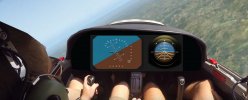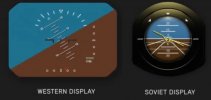Anyone know how full-scale drones or commercial instrumentation is set up?
DJI's attitude indicator uses the old Soviet-style horizon indicator, not the more universally accepted Western-style.
In Western-style attitude indicators, the aircraft symbol remains fixed in the face of the instrument. It is the horizon line that moves, the border between the brown earth and blue sky. The horizon line always corresponds to where the horizon is currently located as seen from within the cockpit.
DJI's hybrid indicator works like the Soviet-style indicator. The horizon line moves up and down correctly corresponding to how the horizon actually moves, but it remains fixed in the instrument face as the aircraft rolls. Instead the aircraft symbol rolls to show the aircraft's roll angle.
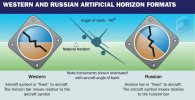
In my illustration below, you can see the display of the Western-style instrument corresponding precisely to where the horizon actually is.
But the Soviet-style display used in DJI's instrument is doubly confusing because the white lines are showing two completely separate things. In the up/down axis, the lines are correctly showing the "horizon" located higher than the nose of the plane. But in the roll axis, the white lines are instead showing the plane's "wings" rolled to the right.
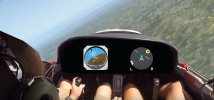
If you've been trained to use one or the other, either the more commonly used Western-style or the bizarre Soviet-style, then I suppose whichever one you're accustomed to will make more sense to you. But I wish we had a choice to set the instrument to our own preference.
The danger comes from expecting the instrumentation to work in the manner in which you've been trained. DJI's display moves
backwards to what I'm used to seeing. For me it's confusing and dangerous, so I don't use it.
In its latest version, DJI replaced the white lines with an even more confusing black sky over blue water. It's completely wrong, unless you're Soviet.
The discrepancy between Soviet-style and Western-style attitude indicators has led to several fatal crashes. Search YouTube for "
Crossair Flight 498".
In this documentary, they spend a long time investigating other possible causes of the crash, but from 29 minutes onward they focus on the discrepancy between Soviet-style vs. Western-style artificial horizon instruments.
At 30:13 in the video this diagram is used to illustrate how a
left-bank shown on a Soviet display might be confused with a
right-bank shown on a Western display.
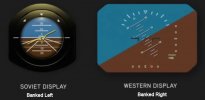
I find that even more confusing because it actually
does show the plane in two different attitudes. So here's how it would look with the aircraft banked to the
right in both cases.
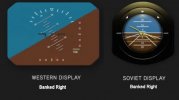
And below is how it would look inside the plane, with the nose pointed at the horizon and the plane rolled to the
right. Note the Western-style display accurately and intuitively corresponds to where the horizon is currently located. The Soviet-style (and DJI) instrument instead confusingly shows the horizon fixed level inside the display and the plane's wings rolled to the right, neither of which bear any resemblance to what is seen through the windshield.
